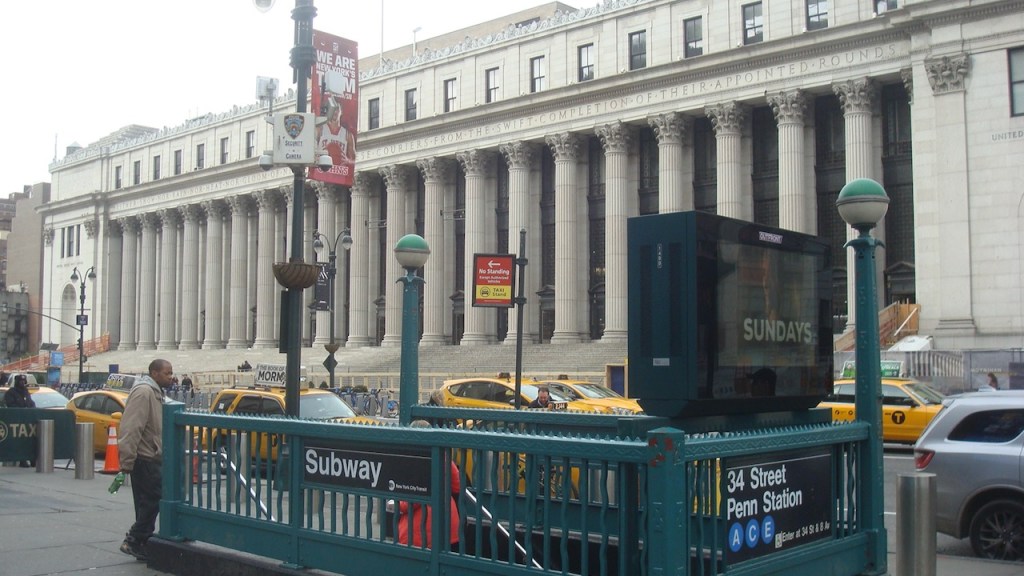
The future of rail transit from New Jersey to New York City has been in the news recently, with President Biden appearing in New York last week to celebrate the first steps in the Gateway Project, which will eventually lead to construction of the first new rail tunnesl across the Hudson River in over 100 years. Construction is beginning thanks to funding from the Bipartisan Infrastructure Law, which Biden signed in 2021. New tunnels would allow more trains to run into New York Penn Station, but this brings a new problem, because the station can’t take any more trains right now. Fortunately, Amtrak, which owns the station, has a plan…
In recent years, there has been a major push to improve New York Penn Station, which, it is probably fair to say, is not a well-loved transit hub. The James Farley Post Office was converted into Moynihan Hall, a spacious new annex for the station. Refurbishment of the old station, to raise ceilings and improve lighting, is under way. And last fall, the MTA selected architects to design a further renovation of the passenger concourse, at an estimated cost of $7 billion.
None of these improvements allow more NJ Transit or Amtrak trains to enter Penn Station, however. There are no avilable slots, which means, for example, that NJ Transit Raritan Valley Line trains usually have to terminate at Newark instead of continuing into the city. Even if the new Gateway tunnels are constructed, this lack of capacity will still exist. To solve this problem, Amtrak signed a contract last year with UK-based engineering firm Arup to identify the best way to increase the number of trains that can use the station. Through an OPRA request, we obtained the full project brief (link to full document).
The narrow platforms at NY Penn Station limit the number of trains that can use the station. It takes a long time to deboard all the passengers from a train, and for them to clear the platform through staircases and escalators. That also means that passengers waiting for NJ Transit trains at Penn Station have to hang around in a waiting area known as ‘The Pit’, and then stampede down to trains when the track is announced.

One way to make it easier to manage trains coming into Penn Station would be to have more tracks available. Another alternative, which has been floated by various activists, would be for passenger trains entering Penn Station from New Jersey to continue through new tunnels to Grand Central Station and then to Long Island or Connecticut. This ‘through-running’ approach might result in more passengers getting on and off at other stations, reducing the crush at Penn, and allowing trains to enter and exit the tracks at the station more quickly.
Notably, the design study does not specify which alternative should be followed. Instead, it specifies that the design outcome should “accomodate a doubling or more of peak hour train capacity under the Hudson River”. The implications of this for rail passengers in New Jersey are tremendous. Many more trains could run into New York, allowing far better frequency of service, and direct service to the city from regional stations that currently have none.
The project brief does discuss several alternatives for adding new tracks. These are focused on acquisition of buildings in the blocks south of Penn Station to build new tracks. This could take the form of “8 or 9 new tracks, roughly to the depth of existing Penn Station’s track level” or a “bi-level station…with upper tracks roughly at the depth of existing Penn Station’s track level and lower level tracks to be accessed separately”. These ‘Penn South’ concepts have been the subject of previous planning studies performed by Amtrak and NJ Transit, which will inform the new planning exercise. The idea of “through-running” is very much still on the table, however. In fact the planning brief requires that “consultant will evaluate track configurations to accommodate train movements for the planned capacity and allow future through running“.
A Service Building for Penn Station would also be relocated to this area. Part of the cost of all this would be funded by construction of a new “ultra-high rise overbuild” in this area. The consultants will have to consider how all this might be achieved, working alongside stakeholders including Amtrak and NJ Transit to develop the final design. Although most of the contract with Arup is redacted, the cost for the study is $73,143,722.00. That’s a lot of money, but it’s probably a drop in the bucket compared to how much it would cost to expand Penn Station track capacity, although a lot of funds could probably be raised through new real estate development in the area.
Links: RFP and redacted contract with Arup for Penn Station New York track expansion.
